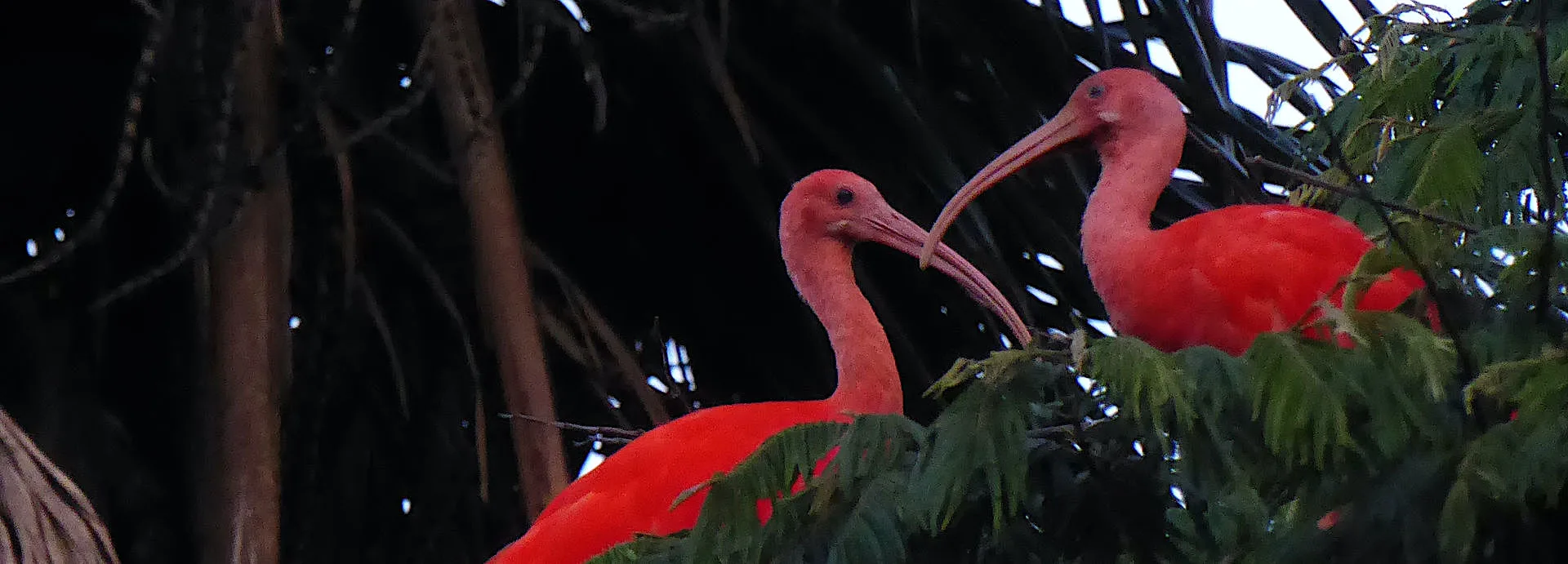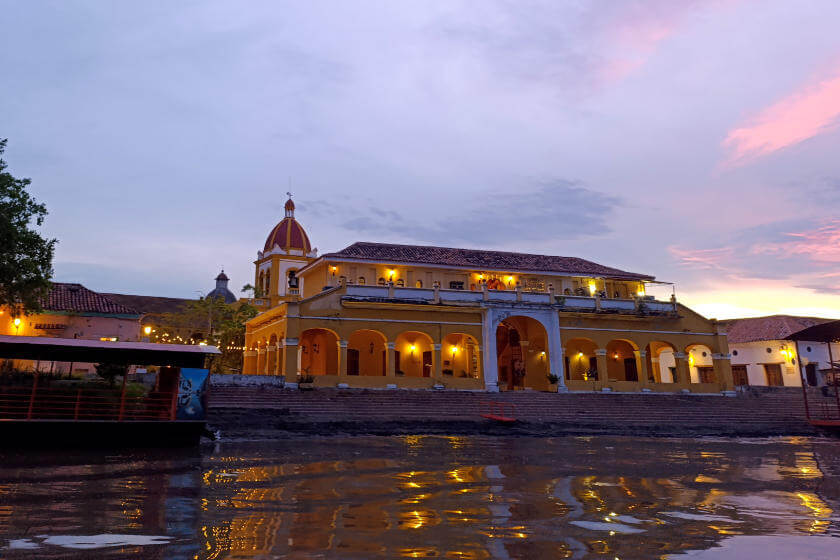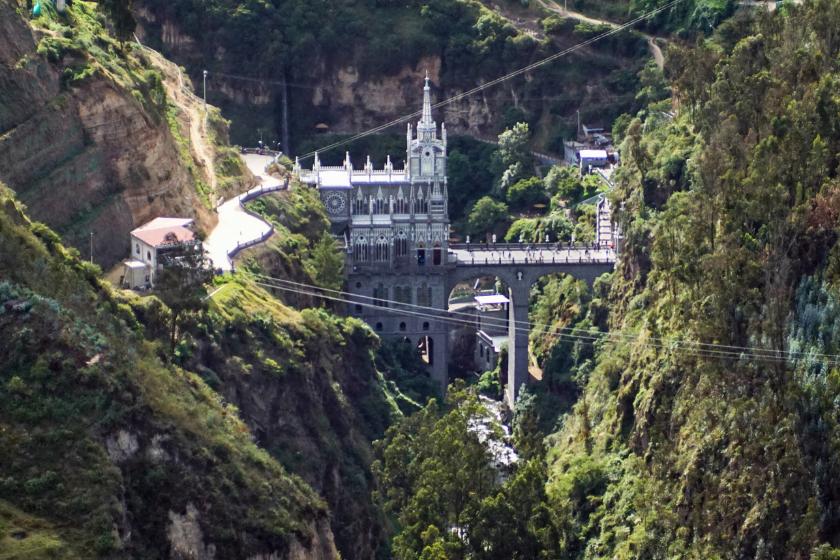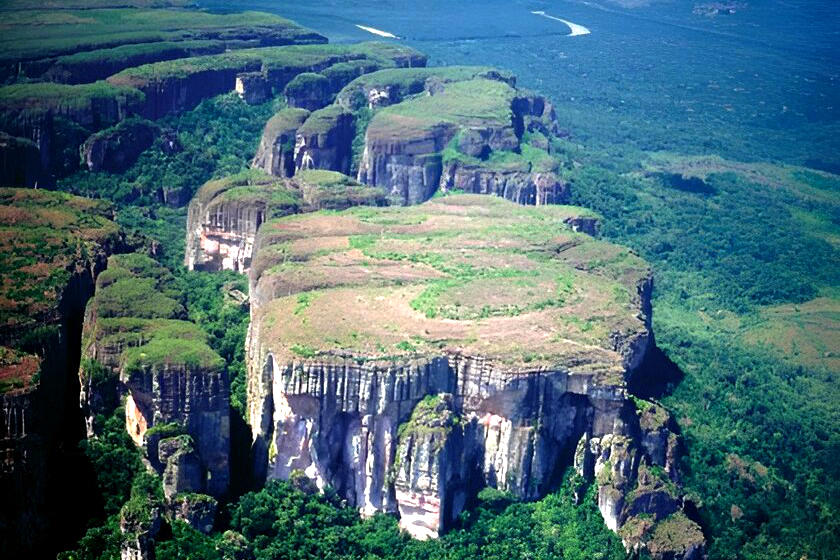
Colombia is full of fascinating off-the-beaten-track destinations and hidden gems (which might sometimes also be called “stranger things”). The country is a sheer paradise for curious and adventurous solo travelers looking to venture beyond the typical tourist trail! On this page, I’ve put together some inspiration for your unique Colombia experience off-the-beaten-path.
For your orientation, I’ve created a simplified map of Colombia with a rather rough division of the country into Center, South, East, North, West, and Islands. The map on the right shows the natural regions of Colombia.

Map on the right based on Political division and natural regions of Colombia Map ResearchGate, CC-BY (modified)
The center of Colombia ecompasses the Andean regions of Cundinamarca, Caldas, Risaralda, Quindío, Tolima, Boyacá and parts of Antioquia). There are at least as many hidden gems in the center as there are top tourist attractions. Here are some great off-the-beaten-track travel destinations.
You may have heard of the wax palms in Valle del Cocora near Salento. Locals say the palms in Bosque de Palmas de Cera (Wax Palm Forest) “La Samaria”, close to San Felix in Risaralda, are even more majestic. Charming little San Felix is itself a hidden gem. You can reach San Felix in about 3 hours from Medellin. View more details in my article about things to do in and near Medellin.

The Rio Claro Nature Reserve close to Doradal (4 hours from Medellin) is a little outdoor paradise where you can go hiking, river rafting, tubing, and more. It’s also great for wildlife spotting and birdwatching. It’s still a hidden gem but rather easy to reach as it is located between Medellin and Bogota. (View on Google Maps)

Photo by Nicole (Travelhapp), Rio Claro
The beautiful La Miel River and the immense Amaní Reservoir are set in a spectacular hilly green landscape close to Norcasia in the Caldas department. You can spend the night in a little cottage with a jacuzzi and a lake view and engage in river activities, like body rafting and tubing, during the day. On the shores of the river, you may spot howler monkeys and multicolored birds. Read more about Rio la Miel
Check out my short video about Rio la Miel and Embalse Amani on TikTok.
@travelhapp Rio la Miel and Embalse Amaní in Norcasia, Colombia. Pure joy . . . . . #colombiatravel #slowtraveler #femalesolotraveler #hiddenparadise #discovercolombia
♬ Quiero Enamorarte - Grecia Vallejo

Photo by Nicole (Travelhapp), Embalse Amaní, Norcasia
Honda is a picturesque colonial town on the Magdalena River and one of my personal favorite places in Colombia – a hidden gem, perfect for leisurely strolls and relaxation.
Less than an hour from Honda lies Falan. From there, you can hike through the jungle to the ruins of an abandoned colonial-era gold and silver mining town (“Ciudad Perdida de Falan”). Learn more about these two hidden gems in Tolima!
Due to its guerilla past, the Tolima department as a whole is still an off-the-beaten-path destination full of surprising things to discover. Read more about its capital Ibagué and its stunning surroundings.

Photo by Nicole (Travelhapp), Honda by the Magdalena River
The northern part of Colombia is bordered by the Caribbean Sea and includes the departments Córdoba , Sucre, Bolívar, Atlántico , Magdalena, Cesar, La Guajira and Norte de Santander, plus Santander in the northeast. Most of northern Colombia is part of the “Caribbean region”.
The north of Colombia is of immense natural beauty and diversity and it also hosts myriad of hidden gems and off-the-beaten-track destinations.

Photo by Travelhapp: Valledupar Colombia, Historical Center
Mompox (Santa Cruz de Mompós), located on an island in the Magdalena River, is a fascinating destination for anyone interested in history and colonial architecture. This dreamy “Sleeping Beauty” was difficult to reach for a long time – and that’s precisely what has preserved its unique charm and its impressive colonial old town.
Nowadays, Mompox is relatively easy to reach: either by minivan from Valledupar (about 4 hours), or by bus from Barranquilla (about 7 hours) or Cartagena (about 7 hours).

Photo by Nicole (Travelhapp), Mompox by the Magdalena river, Colombia
The remote locations of Cabo de la Vela and Punta Gallinas on the La Guajira Peninsula in the far north of Colombia are characterized by surreal landscapes and a unique culture. Massive sand dunes meet the turquoise sea, and at night, you can see countless stars. La Guajira is the ancestral home of the indigenous Wayuu, who possess rich traditions and their own language.
You can book tours to Cabo de la Vela and Punta Gallinas both from Riohacha and Santa Marta. I’d recommend going to Riohacha by bus and taking the tour from there to save on transport costs. Check out this top-rated 3-day small group La Guajira tour* at GetYourGuide.
Discover more about Things to do in La Guajira.

Photo by Nicole (Travelhapp), Cabo de la Vela (La Guajira)
Rincón del Mar is a small peaceful fishing village with beautiful Caribbean beaches around 2,5 hours south of Cartagena. Find out more in my article on things to do near Cartagena.

Photo by Yassef Briceño García, CC BY 2.0, Rincón del Mar (mod.)
The small village of Don Diego is less than half an hour from the popular hippie getaway of Palomino. Similar to Palomino, you can also float down the river to the sea on an inner tube here (i.e., tubing), but it’s much quieter. When I was there, my boatman and I were the only ones around for miles, and I could enjoy the silence while watching colorful birds and howler monkeys on the riverbank. An unforgettable experience.

Photo by Nicole (Travelhapp), Don Diego River meeting the sea
Charming and underrated Guadalupe, conveniently located between Villa de Leyva and Bucaramanga, is a great outdoor travel destination offering activities like hiking and body rafting. The most unique sight in Guadalupe is the Gachas de Guadalupe, impressive natural jacuzzis in a multi-colored river. A beautiful hiking trail through an amazing landscape leads from the edge of the village to this natural wonder.

Photo by Nicole (Travelhapp), Gachas de Guadalupe
The western part of Colombia is bordered by the Pacific Ocean and encompasses the departments of Chocó, Valle del Cauca, Cauca, and the coastal areas of Nariño. Further inland, you’ll find Pasto, the capital of Nariño, as well as Huila in the south-central Andes and parts of Antioquia in the northwest. Western Colombia is full of paradisiacal off-the-beaten-track destinations and hidden gems.

Photo by SteetFlash, Utria National Park, Nuqui, Canva Pro license
Sapzurro (near Capurganá) is a picturesque little village right at the border to Panama with pristine white beaches and turquoise Caribbean waters. You can find abundant wildlife inside and outside of the water in this hidden paradise where the jungle meets the sea. Read more about the Chocó Region (Sapzurro, Nuqui, Bahia Solano).

Photo by jkraft5, Sapzurro

Photo by miniteca.org, CC BY-SA 2.0, San Cipriano River, waterfall (mod.)
The Tatacoa desert with its moon-like landscape and starry nights is a breath-taking off-the-beaten-track destination in Colombia. Local guides can tell you why you can find marine fossils in this desert.
The Tatacoa desert is only one of the hidden treasures to be discovered in Huila. Find out more about secret attractions in Huila.

Photo by Nicole (Travelhapp), Tatacoa Desert Colombia
Las Lajas Sanctuary, a neo-Gothic church near the Ecuadorian border, offers an absolutely unique setting.
The entire Nariño region is full of breathtaking landscapes and natural sights – and is still relatively unvisited. Read more about Nariño and its capital Pasto.

Photo by ANPerryman, Las Lajas Sanctuary (mod.)
Popayán in Colombia is strongly associated with religious tourism due to its famous easter processions. However, this beautiful “white city” is a true hidden gem for every kind of traveler to discover – with a great culinary offer, nice bars with live music, gorgeous colonial architecture and amazing natural surroundings that include, for example, the Puracé National Natural Park, where you can spot the Andean condor.
Popayán is one of my favorite slow travel destinations in Colombia. Discover things to do and see in Popayán

Photo by Nicole (Travelhapp): Sunset over Popayán

The east of Colombia is sparsely populated and extremely fascinating. The departments Meta, Casanare, Vichada, Arauca, and parts of Guaviare belong to the so-called “Llanos Orientales” (‘the eastern plains”). The Llanos, which are situated in the Orinoco region, border with Venezuela, as does remote and mystical Guainía. The East of Colombia is as off-the-beaten-track as it can get, full of secret and magical places.
Caño Cristales in the Colombian Macarena province is called “the river of 7 colors”, or “liquid rainbow”, since it takes on multiples colors between June and November. The colors are caused, among other things, by water plants and algae that change from red to yellow and green depending on their exposure to the sun.
Caño Cristales can be reached from Villavicencio with the airline Satena between July and November. At Civitatis.com you can book a top-rated Caño Cristales tour* from La Macarena online. Read more about Villavicencio and the fascinating Meta department.

Photo by Pedro Szekely, CC BY-SA 2.0, Caño Cristales (mod.)
The department of Guaviare was basically inaccessible before the peace contract in 2016 due to massive guerrilla presence. Although parts of the region continue to face challenges from dissident groups, its capital, San José del Guaviare, is increasingly opening up to travelers seeking unique experiences off the beaten path.
The pristine Chiribiquete National Natural Park with its iconic tabletop mountains and dense concentration of prehistoric rock paintings is a UNESCO World Heritage Site. However, it is not open to the public and can only be seen by air (on authorized flights). You can visit several other spectacular sites from San José del Guaviare, though, including the prehistoric rock art of Cerro Azul, the surreal rock formation known as the Orion Gate, and Caño Sabana, a multicolored river that rivals the beauty of the more famous Caño Cristales.
To explore these natural wonders, you can book a 3-day Guaviare Community Tour* from San José del Guaviare with excellent participant ratings at Viator.com. There is also a day tour to Cerro Azul (Viator.com)* available.

Photo by Carlos Castaño Uribe, CC BY-SA 3.0, Chiribiquete National Natural Park (mod.)

Photo by Carlos Castaño Uribe, CC BY-SA 3.0, Chiribiquete Rock Paintings (mod.)

Photo by AA Lombana-Bermudez, CC BY-SA 2.0, Cerros de Mavecure (mod.)
The southern part of Colombia shares borders with Ecuador, Brazil and Peru and large parts are covered by the amazon rainforest. It includes the departments Amazonas, Putumayo, Caquetá, and Vaupés.
Large parts of the south are located off the beaten track due to their difficult accessibility. Guerrilla groups also continue to be present in parts of Putumayo, Caquetá, and Vaupés. Therefore, be sure to check current travel advisories if you plan to visit these regions.
Small Mocoa is the capital of the Putumayo department in Colombia’s Amazon region. Putumayo is less explored than the Amazon rainforest around Leticia. Close to Mocoa you can visit the magical “End of the World” waterfall Cascada del Fin del Mundo which is surrounded by dense jungle.

Photo by Cecilia Posada, rainforest mountain near Mocoa (mod.), Canva Pro license
The idyllic Amazon village of Puerto Nariño is located two hours upriver from Leticia and specializes in community-based ecotourism.
Amacayacu National Natural Park is easily accessible by boat from Puerto Nariño and Leticia, offering fantastic opportunities for wildlife and bird watching. You may see pink dolphins, sloths, capybaras, woolly monkeys, tapirs, macaws, parrots, and many other species. The jaguar also inhabits Amacayacu National Park, but it is very hard to see this graceful cat since it is very elusive.
You can book an affordable hiking tour in Amacayacu Park* from Puerto Nariño, for example, online through Civitatis. However, for a deep jungle experience, I would also recommend a multi-day tour, such as this 3-day Amazon tour (Civitatis.com)*. Find out what else to do in the Colombian Amazon.

Photo by Dick Culbert, CC BY 2.0, Woolly monkey in Amacayacu National Park
The Insular Region of Colombia refers to the islands in the Atlantic and Pacific Oceans that are geopolitically part of Colombia. These islands include Malpelo and Gorgona in the Pacific Ocean, San Andrés and Providencia in the Caribbean Sea, as well as the Archipiélago de San Bernardo, Islas del Rosario, Isla Fuerte, Isla Barú, Isla Tortuguilla, and Isla Tierra Bomba.

Photo by Guillermo Bresciano, Providencia Cabo Cangrejo (mod.)
Gorgona Island is a fascinating off-the-beaten-path destination in Colombia and, as a recognized national park, offers an extremely diverse flora and fauna. You can also visit the ruins of the prison that used to be on the island. Gorgona Island is one of Colombia’s certified sustainable tourism destinations.

Photo by Clement Recoules, Aviatur, CC BY-SA 3.0, Gorgona Island (mod.)
Colombia’s hidden gems have sparked your wanderlust? For your next level, explore these 9 truly epic Colombia adventures where a guide is essential!
Share:
Last Update: September 20, 2025
*Affiliate links: Some links on this page are affiliate links. By booking through these links, you can support my work on Travelhapp – at no extra cost for you. I only recommend products and services I trust and believe will provide value to you.
© 2025 Travelhapp.com
To provide the best experiences, we use technologies like cookies to store and/or access device information. Consenting to these technologies will allow us to process data such as browsing behavior or unique IDs on this site. Not consenting or withdrawing consent, may adversely affect certain features and functions. View our Privacy & Cookie Policy